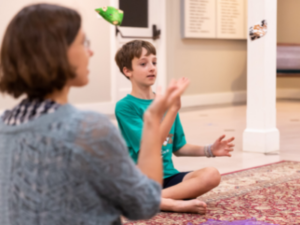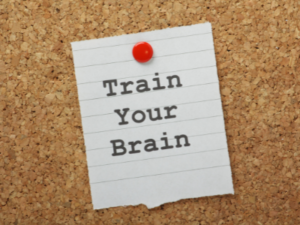At CCM, we often talk about taking a holistic approach to teaching music, one that emphasizes musicianship. Musicianship is the difference between learning how to technically play an instrument versus becoming a musician.
We encourage students to see themselves as musicians from the moment they begin studying music. For students of all ages, understanding and taking ownership of their music sets them up to succeed as they find joy in the experience of becoming a musician.
This process involves several aspects of musical training and appreciation.
Internalizing the rhythm
How many times have you heard someone say, “I have no rhythm,” or “I can’t find the beat”? People often believe that the ability to follow a beat is something you are born with, when in fact, rhythm is learned.
In our early childhood classes, you might see students practicing walking to the rhythm, using their bodies to find the  beat. As the rhythm speeds up or slows down, they speed up or slow down with it. For an older adolescent, finding the beat might involve clapping along until with a rhythm until they are comfortable with it — and then continuing to clap out the rhythm when the music stops. With adults, we might ask students to thump their chests on the downbeat to internalize the rhythm.
beat. As the rhythm speeds up or slows down, they speed up or slow down with it. For an older adolescent, finding the beat might involve clapping along until with a rhythm until they are comfortable with it — and then continuing to clap out the rhythm when the music stops. With adults, we might ask students to thump their chests on the downbeat to internalize the rhythm.
Feeling the music in your body and your head helps you better recognize how music should sound when you play it.
Training the ear (which means training the brain)
You’ve likely heard of “ear training” or audiation. The phrase “ear training” is somewhat of a misnomer: you are actually training your brain to hear and identify notes.
People described as having perfect pitch can hear a note and immediately identify it. This, again, is a learned skill,  and it is why we emphasize singing as a skill for every musician and not just vocalists. Developing vocal skills returns every student to the foundational elements of music.
and it is why we emphasize singing as a skill for every musician and not just vocalists. Developing vocal skills returns every student to the foundational elements of music.
We see brain training with students learning to play a stringed instrument that does not have frets, like a violin and a cello. Those musicians learn where to put their fingers on the fingerboard and develop muscle memory of how a note sounds in tune.
Developing creativity
There are different ways to think about creativity and to build it into learning from the earliest lessons.
Nurturing creativity can be as simple as asking a student who is learning a scale to play four bars in a C major scale rather than just instructing them to play the C major scale. By coming up with the notes themselves, the student is getting a taste of improvisation.
A more involved way to work on creativity can be generating rhythm patterns, such as through a call and response exercise where an instructor has students repeat then build on each other’s rhythms.
As a musician becomes more accomplished, creativity takes on the ultimate form with the joy of true improvisation and composition.
Why musicianship matters
We hear all the time from adults who express their regret at having “given up” on music lessons when they were younger. Some say they just weren’t born musicians. Others remember boredom or a challenging instructor.
In reality, students who lose interest in music, grow bored or resentful, or believe they lack talent are the consequence of teaching without musicianship. Those students have not been engaged in the world of music; they feel they are “pressing buttons” or “reading dots on a page.” They aren’t taught to draw connections between their lessons and the music they listen to for fun. Without the benefit from ear and brain training, they don’t develop the skills necessary to play in an ensemble. It’s no wonder music lessons become a burden for these students.
It is our responsibility, as guides and instructors, to help our students develop musicianship and to become musicians. At CCM, we bring an awareness of that responsibility to everything we do, from our earliest interactions.
Witnessing musicianship
If you attend our recitals and study the musicians performing, you might notice students who are not just playing the notes on the page, but who are incorporating the dynamics of the music, the soft and the loud, and engaging their bodies as they move with the music. You are witnessing musicianship in action.
Our emphasis not just on playing but also on understanding the structure of music deepens the experience and builds skills and confidence beyond expectations.
When students have opportunities to internalize music, develop ear and brain training, experiment with creativity, and make music their own, they develop a lifelong interest in what they are studying — and ownership of what they are creating.
Are you ready to learn and enjoy creating music? Find out how you can become a musician.
Back To Top